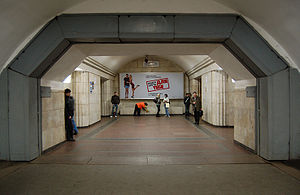Arsenalna (Kiev Metro)
|
Arsenalna
|
|||||||||||
|---|---|---|---|---|---|---|---|---|---|---|---|
|
|
|||||||||||

The Station Hall
|
|||||||||||
| Coordinates | 50°26′40″N 30°32′44″E / 50.44444°N 30.54556°ECoordinates: 50°26′40″N 30°32′44″E / 50.44444°N 30.54556°E | ||||||||||
| Owned by | Kiev Metro | ||||||||||
| Line(s) |
|
||||||||||
| Platforms | 1 | ||||||||||
| Tracks | 2 | ||||||||||
| Construction | |||||||||||
| Structure type | underground | ||||||||||
| Depth | 105.5 m (346 ft) | ||||||||||
| Platform levels | 1 | ||||||||||
| Other information | |||||||||||
| Station code | 121 | ||||||||||
| History | |||||||||||
| Opened | 6 November 1960 | ||||||||||
| Electrified | Yes | ||||||||||
| Services | |||||||||||
|
|||||||||||
Arsenalna (Ukrainian: Арсена́льна, translit. Arsenalna, IPA: [ɐrseˈnɑlʲnɐ]) is a station on Kiev Metro's Sviatoshynsko-Brovarska Line. The station was opened along with the first stage and is currently the deepest station in the world (105.5 metres (346 ft)). This is attributed to Kiev's geography where the high bank of the Dnieper River rises above the rest of the city. Also unique is the station's design which lacks a central concourse thus similar in layout to stations on the London Underground.
Although Arsenalna (architects H. Hranatkin, S. Krushynsky, N. Shchukina) appears as a pylon trivault, the "Pylons" along with their portals are all purely cosmetic decoration. Pink marble walls with bronze grills (that feature metallic artwork on Soviet themes) (Soviet stars are due to be removed due to 2015 decommunization laws) is all that is present in the portal. Instead the station has a small lobby which is directely connected to the escalator tunnel. The ride on the escalators itself is one of the longest totaling up to five minutes.
The layout of the stations has reasons, as the cosmetic pylons were planned to be real. The main one comes from the tough soils of the location and the problems with hydroisolation which forced the builders to conserve the design. Similar problems happened on the first stage in Moscow however later the stations Lubyanka and Chistye Prudy were completed. In Kiev this never was to happen. Originally built as an interim on a long track before the line crossed the Dnieper and continued into the left bank residential districts, it was never to have a large passenger traffic to justify a complex and costly reconstruction. Nor was the station ever planned to be a transfer point (unlike the Moscow stations, which ultimately was the reason for them to be rebuilt). Thus with the Kiev Arsenal Factory, for which the station was named, being the only human source of passengers, this station is likely to remain as it is permanently.
...
Wikipedia
